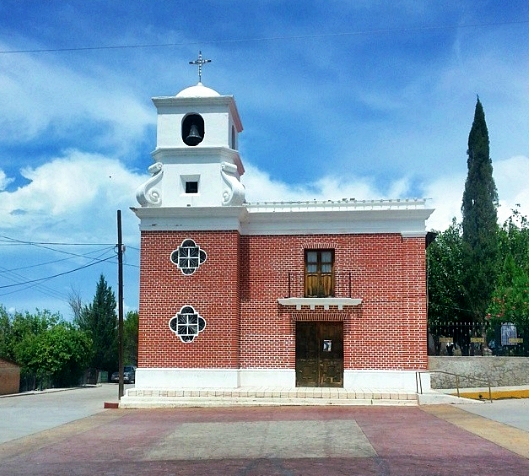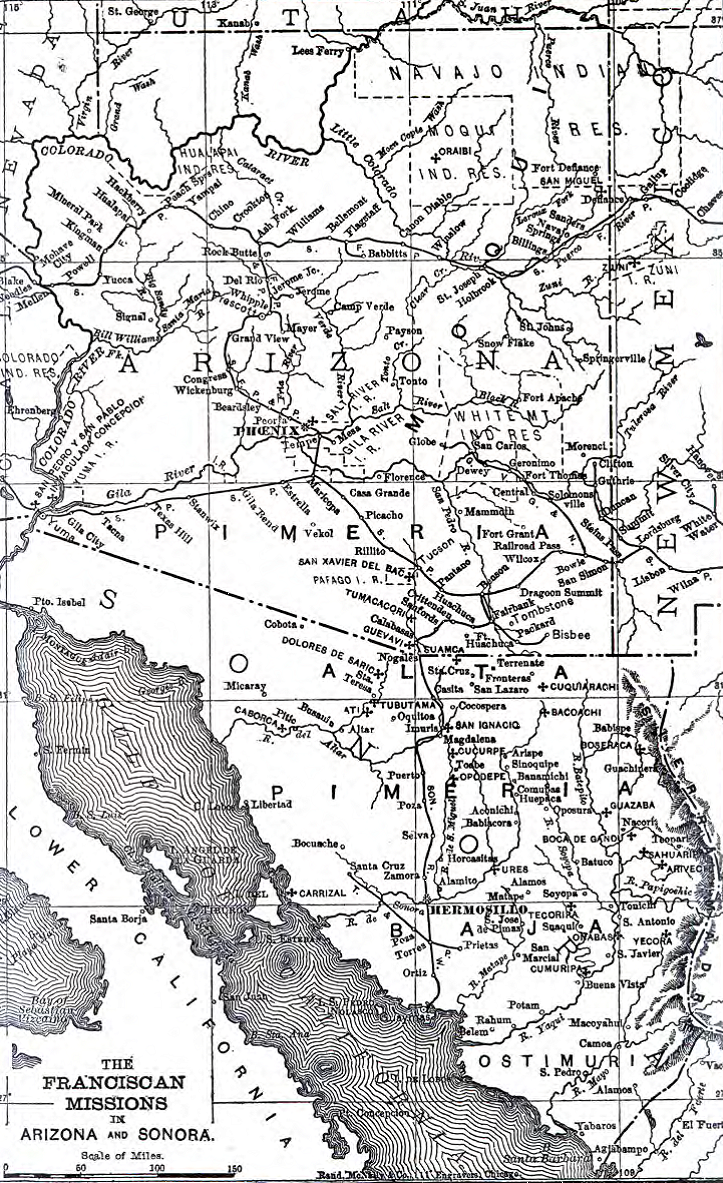|
Fronteras
Fronteras is the seat of Fronteras Municipality in the northeastern part of the Mexican state of Sonora. Frontera translates as Border. The elevation is 1,120 meters and neighboring municipalities are Agua Prieta, Nacozari and Bacoachi. The area is 2839.62 km2, which represents 1.53% of the state total. Fronteras was founded by the Jesuits as a mission in 1645. Geography Fronteras is located in a mountainous area on the west side of the Sierra Madre Occidental. The average annual temperature is 16.9 °C. The rainy season is from July to August and the average annual rainfall is 427.5 millimeters. Demographics and industry The municipal population was 7,081 (2.34 /km2) in 2000, although in a second counting in 2005 this had increased to 7,470. The most important settlement and the municipal seat had 874 inhabitants in 2000. Industry is the most important economic activity together with agriculture and cattle raising. There was one ''maquiladora'' in 2000. The main ag ... [...More Info...] [...Related Items...] OR: [Wikipedia] [Google] [Baidu] |
Juan Bautista De Anza
Juan Bautista de Anza Bezerra Nieto (July 6 or 7, 1736 – December 19, 1788) was an expeditionary leader, military officer, and politician primarily in California and New Mexico under the Spanish Empire. He is credited as one of the founding fathers of Spanish California and served as an official within New Spain as Governor of the Province of New Mexico. Early life Juan Bautista de Anza Bezerra Nieto was born in Fronteras, New Navarre, New Spain (today Sonora, Mexico) in 1736 (near Arizpe), most probably at Cuquiarachi, Sonora, but possibly at the Presidio of Fronteras. His family was a part of the military leadership in Nueva España, as his father and maternal grandfather, Captain Antonio Bezerra Nieto, had both served Spain, their families living on the frontier of Nueva Navarre. He was the son of Juan Bautista de Anza I. It is traditionally thought that he may have been educated at the College of San Ildefonso in Mexico City, and later at the military academy there. In ... [...More Info...] [...Related Items...] OR: [Wikipedia] [Google] [Baidu] |
Municipalities Of Sonora
Sonora is a state in Northwestern Mexico that is divided into 72 municipalities. According to the 2020 Mexican Census A census is the procedure of systematically acquiring, recording and calculating information about the members of a given population. This term is used mostly in connection with national population and housing censuses; other common censuses incl ..., it is the eighteenth most populated state with inhabitants and the 2nd largest by land area spanning . Municipalities in Sonora are administratively autonomous of the state according to the 115th article of the 1917 Constitution of Mexico. Every three years, citizens elect a municipal president (Spanish: ''presidente municipal'') by a plurality voting system who heads a concurrently elected municipal council (''ayuntamiento'') responsible for providing all the public services for their constituents. The municipal council consists of a variable number of trustees and councillors (''regidores y síndicos''). Munici ... [...More Info...] [...Related Items...] OR: [Wikipedia] [Google] [Baidu] |
Sonora
Sonora (), officially Estado Libre y Soberano de Sonora ( en, Free and Sovereign State of Sonora), is one of the 31 states which, along with Mexico City, comprise the Administrative divisions of Mexico, Federal Entities of Mexico. The state is divided into Municipalities of Sonora, 72 municipalities; the capital (and largest) city of which being Hermosillo, located in the center of the state. Other large cities include Ciudad Obregón, Nogales, Sonora, Nogales (on the Mexico–United States border, Mexico-United States border), San Luis Río Colorado, and Navojoa. Sonora is bordered by the states of Chihuahua (state), Chihuahua to the east, Baja California to the northwest and Sinaloa to the south. To the north, it shares the Mexico–United States border, U.S.–Mexico border primarily with the state of Arizona with a small length with New Mexico, and on the west has a significant share of the coastline of the Gulf of California. Sonora's natural geography is divided into three ... [...More Info...] [...Related Items...] OR: [Wikipedia] [Google] [Baidu] |
Fronteras Municipality
Fronteras Municipality is a municipality in Sonora in north-western Mexico Mexico (Spanish: México), officially the United Mexican States, is a country in the southern portion of North America. It is bordered to the north by the United States; to the south and west by the Pacific Ocean; to the southeast by Guatema .... References {{coord, 30.8215, N, 109.6062, W, source:wikidata, display=title Municipalities of Sonora ... [...More Info...] [...Related Items...] OR: [Wikipedia] [Google] [Baidu] |
Agua Prieta
Agua Prieta (English: ''Dark Water'', Opata: ''Bachicuy'') is a town in Agua Prieta Municipality in the northeastern corner of the Mexican state of Sonora. It stands on the Mexico–U.S. border, adjacent to the town of Douglas, Arizona. The municipality covers an area of 3,631.65 km2 (1,402.2 sq mi). In the 2010 census the town had a population of 79,138 people, making it the seventh-largest community in the state, and a literacy rate of 96.3%. 89% of the homes in the city have electricity, 94% have running water, and 86% are connected to the sewer system. The city's most important economic activities, in descending order, are industry, commerce and farming. The city is the location of the CFE Agua Prieta power plant. It is connected to the United States by the Douglas, Arizona Port of Entry, and is linked to the rest of Mexico by Federal Highways 2 and 17. History Agua Prieta city began at the end of the 19th century as railroads were built between Douglas, Arizona ... [...More Info...] [...Related Items...] OR: [Wikipedia] [Google] [Baidu] |
Bacoachi
Bacoachi is a small town in Bacoachi Municipality in the north of the Mexican state of Sonora. The area of the municipality is 487 square miles (1,260.65 km²) and the population (rural and urban) was 1,456 in 2005, with 924 inhabitants residing in the municipal seatThe elevation of the municipal seat is 4,429 feet (1,350 meters) above sea level. Bacoachi is located southeast of Cananea and has boundaries in the north with Naco, in the east with Fronteras, in the southeast with Nacozari, in the southwest with Arizpe and in the east with Cananea. See maps ao The territory was originally inhabited by the Opata Teguima Indians, who called their settlement "Cuchibaciachi". In 1649, Captain Simón Lazo de la Vega founded a Spanish town in the same spot. The name means "water snake" in the indigenous language. Most of the land is mountainous and is part of the Sierra de Sonora. There are still pine forests and a rich variety of fauna, including coyotes, jaguars, deer, raccoons ... [...More Info...] [...Related Items...] OR: [Wikipedia] [Google] [Baidu] |
Spanish Missions In The Sonoran Desert
The Spanish missions in the Sonoran Desert ( es, Misiones jesuíticas en el desierto de Sonora) are a series of Jesuit Catholic religious outposts established by the Spanish Catholic Jesuits and other orders for religious conversions of the Pima and Tohono O'odham indigenous peoples residing in the Sonoran Desert. An added goal was giving Spain a colonial presence in their frontier territory of the Sonora y Sinaloa Province in the Viceroyalty of New Spain, and relocating by Indian Reductions (''Reducciones de Indios'') settlements and encomiendas for agricultural, ranching, and mining labor. Geography and history The missions are in an area of the Sonoran Desert, then called "Pimería Alta de Sonora y Sinaloa" (Upper Pima of Sonora and Sinaloa), now divided between the Mexican state of Sonora and the U.S. state of Arizona. Jesuits in missions in Northwestern Mexico wrote reports that throw light on the indigenous peoples they evangelized. A 1601 report, ''Relación de la Pro ... [...More Info...] [...Related Items...] OR: [Wikipedia] [Google] [Baidu] |
List Of Sovereign States
The following is a list providing an overview of sovereign states around the world with information on their status and recognition of their sovereignty. The 206 listed states can be divided into three categories based on membership within the United Nations System: 193 UN member states, 2 UN General Assembly non-member observer states, and 11 other states. The ''sovereignty dispute'' column indicates states having undisputed sovereignty (188 states, of which there are 187 UN member states and 1 UN General Assembly non-member observer state), states having disputed sovereignty (16 states, of which there are 6 UN member states, 1 UN General Assembly non-member observer state, and 9 de facto states), and states having a special political status (2 states, both in free association with New Zealand). Compiling a list such as this can be a complicated and controversial process, as there is no definition that is binding on all the members of the community of nations concerni ... [...More Info...] [...Related Items...] OR: [Wikipedia] [Google] [Baidu] |
Francis Drake
Sir Francis Drake ( – 28 January 1596) was an English explorer, sea captain, privateer, slave trader, naval officer, and politician. Drake is best known for his circumnavigation of the world in a single expedition, from 1577 to 1580 (the first English circumnavigation, the second carried out in a single expedition, and third circumnavigation overall). This included his incursion into the Pacific Ocean, until then an area of exclusive Spanish interest, and his claim to New Albion for England, an area in what is now the U.S. state of California. His expedition inaugurated an era of conflict with the Spanish on the western coast of the Americas, an area that had previously been largely unexplored by Western shipping. He was Member of Parliament (MP) for three constituencies; Camelford in 1581, Bossiney in 1584, and Plymouth in 1593. Queen Elizabeth I of England, Elizabeth I awarded Drake a knighthood in 1581 which he received on the ''Golden Hind'' in Deptford. In the same ... [...More Info...] [...Related Items...] OR: [Wikipedia] [Google] [Baidu] |
Guaymas, Sonora
Guaymas () is a city in Guaymas Municipality, in the southwest part of the state of Sonora, in northwestern Mexico. The city is south of the state capital of Hermosillo, and from the U.S. border. The municipality is located on the Gulf of California and the western edge of the Sonoran Desert and has a hot, dry climate and of beaches. The municipality's formal name is Guaymas de Zaragoza and the city's formal name is the Heroica Ciudad de Guaymas. The city proper is mostly an industrial port and is the principal port for the state of Sonora. The city has a well-attended annual carnival, which has been held since 1888. Nearby, San Carlos and its beaches are major tourist attractions. History Before the arrival of the Europeans, the bay of Guaymas was dominated by the Guaymas, Seri and Yaqui tribes. In 1539, two Spanish ships, the ''Santa Águeda'' and the ''Trinidad'', arrived in Guaymas Bay. They were commanded by Francisco de Ulloa, who called the area "the port of ports." ... [...More Info...] [...Related Items...] OR: [Wikipedia] [Google] [Baidu] |
Indigenous Peoples Of The Americas
The Indigenous peoples of the Americas are the inhabitants of the Americas before the arrival of the European settlers in the 15th century, and the ethnic groups who now identify themselves with those peoples. Many Indigenous peoples of the Americas were traditionally hunter-gatherers and many, especially in the Amazon basin, still are, but many groups practiced aquaculture and agriculture. While some societies depended heavily on agriculture, others practiced a mix of farming, hunting, and gathering. In some regions, the Indigenous peoples created monumental architecture, large-scale organized cities, city-states, chiefdoms, states, kingdoms, republics, confederacies, and empires. Some had varying degrees of knowledge of engineering, architecture, mathematics, astronomy, writing, physics, medicine, planting and irrigation, geology, mining, metallurgy, sculpture, and gold smithing. Many parts of the Americas are still populated by Indigenous peoples; some countries have ... [...More Info...] [...Related Items...] OR: [Wikipedia] [Google] [Baidu] |
.jpg)




_2007.jpg)